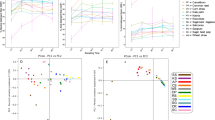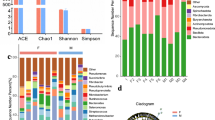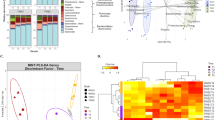Abstract
The moose (Alces alces) is a ruminant that harvests energy from fiber-rich lignocellulose material through carbohydrate-active enzymes (CAZymes) produced by its rumen microbes. We applied shotgun metagenomics to rumen contents from six moose to obtain insights into this microbiome. Following binning, 99 metagenome-assembled genomes (MAGs) belonging to 11 prokaryotic phyla were reconstructed and characterized based on phylogeny and CAZyme profile. The taxonomy of these MAGs reflected the overall composition of the metagenome, with dominance of the phyla Bacteroidetes and Firmicutes. Unlike in other ruminants, Spirochaetes constituted a significant proportion of the community and our analyses indicate that the corresponding strains are primarily pectin digesters. Pectin-degrading genes were also common in MAGs of Ruminococcus, Fibrobacteres and Bacteroidetes and were overall overrepresented in the moose microbiome compared with other ruminants. Phylogenomic analyses revealed several clades within the Bacteriodetes without previously characterized genomes. Several of these MAGs encoded a large numbers of dockerins, a module usually associated with cellulosomes. The Bacteroidetes dockerins were often linked to CAZymes and sometimes encoded inside polysaccharide utilization loci, which has never been reported before. The almost 100 CAZyme-annotated genomes reconstructed in this study provide an in-depth view of an efficient lignocellulose-degrading microbiome and prospects for developing enzyme technology for biorefineries.
Similar content being viewed by others
Log in or create a free account to read this content
Gain free access to this article, as well as selected content from this journal and more on nature.com
or
References
Alneberg J, Bjarnason BS, de Bruijn I, Schirmer M, Quick J, Ijaz UZ et al. (2014). Binning metagenomic contigs by coverage and composition. Nat Methods 11: 1144–1146.
Altschul SF, Gish W, Miller W, Myers EW, Lipman DJ . (1990). Basic local alignment search tool. J Mol Biol 215: 403–410.
Aspeborg H, Coutinho PM, Wang Y, Brumer H 3rd, Henrissat B . (2012). Evolution, substrate specificity and subfamily classification of glycoside hydrolase family 5 (GH5). BMC Evol Biol 12: 186.
Bayer EA, Belaich J-P, Shoham Y, Lamed R . (2004). The cellulosomes: multienzyme machines for degradation of plant cell wall polysaccharides. Annu Rev Microbiol 58: 521–554.
Bayer EA, Coutinho PM, Henrissat B . (1999). Cellulosome-like sequences in Archaeoglobus fulgidus: an enigmatic vestige of cohesin and dockerin domains. FEBS Lett 463: 277–280.
Bengtsson-Palme J, Hartmann M, Eriksson KM, Pal C, Thorell K, Larsson DGJ et al. (2015). metaxa2: improved identification and taxonomic classification of small and large subunit rRNA in metagenomic data. Mol Ecol Resour 15: 1403–1414.
Bensoussan L, Moraïs S, Dassa B, Friedman N, Henrissat B, Lombard V et al. (2017). Broad phylogeny and functionality of cellulosomal components in the bovine rumen microbiome. Environ Microbiol 19: 185–197.
Berg Miller ME, Antonopoulos DA, Rincon MT, Band M, Bari A, Akraiko T et al. (2009). Diversity and strain specificity of plant cell wall degrading enzymes revealed by the draft genome of Ruminococcus flavefaciens FD-1. PLoS One 4: e6650.
Bergström R, Hjeljord O . (1987). Moose and vegetation interactions in northwestern Europe and Poland. Swedish Wildlife Research (Sweden)http://agris.fao.org/agris-search/search.do?recordID=SE8811428.
Bjursell MK, Martens EC, Gordon JI . (2006). Functional genomic and metabolic studies of the adaptations of a prominent adult human gut symbiont, Bacteroides thetaiotaomicron, to the suckling period. J Biol Chem 281: 36269–36279.
Boisvert S, Laviolette F, Corbeil J . (2010). Ray: simultaneous assembly of reads from a mix of high-throughput sequencing technologies. J Comput Biol 17: 1519–1533.
Brás JLA, Cartmell A, Carvalho ALM, Verzé G, Bayer EA, Vazana Y et al. (2011). Structural insights into a unique cellulase fold and mechanism of cellulose hydrolysis. Proc Natl Acad Sci USA 108: 5237–5242.
Brumm P, Mead D, Boyum J, Drinkwater C, Deneke J, Gowda K et al. (2011). Functional annotation of Fibrobacter succinogenes S85 carbohydrate active enzymes. Appl Biochem Biotechnol 163: 649–657.
Buchfink B, Xie C, Huson DH . (2015). Fast and sensitive protein alignment using DIAMOND. Nat Methods 12: 59–60.
Campbell JH, O’Donoghue P, Campbell AG, Schwientek P, Sczyrba A, Woyke T et al. (2013). UGA is an additional glycine codon in uncultured SR1 bacteria from the human microbiota. Proc Natl Acad Sci USA 110: 5540–5545.
Cederlund G, Ljungqvist H, Markgren G, Stalfelt F . (1980). Foods of Moose and Roe-deer at Grimsö in Central Sweden. Results of Rumen Contents Analyses. Swed Wildl Res 11: 170–247.
Cuskin F, Lowe EC, Temple MJ, Zhu Y, Cameron EA, Pudlo NA et al. (2015). Human gut Bacteroidetes can utilize yeast mannan through a selfish mechanism. Nature 517: 165–169.
Dassa B, Borovok I, Ruimy-Israeli V, Lamed R, Flint HJ, Duncan SH et al. (2014). Rumen cellulosomics: divergent fiber-degrading strategies revealed by comparative genome-wide analysis of six ruminococcal strains. PLoS One 9: e99221.
Ding SY, Rincon MT, Lamed R, Martin JC, McCrae SI, Aurilia V et al. (2001). Cellulosomal scaffoldin-like proteins from Ruminococcus flavefaciens. J Bacteriol 183: 1945–1953.
Di Rienzi SC, Sharon I, Wrighton KC, Koren O, Hug LA . (2013). The human gut and groundwater harbor non-photosynthetic bacteria belonging to a new candidate phylum sibling to Cyanobacteria. Elife 2: e01102. http://elifesciences.org/content/2/e01102.abstract.
Duan C-J, Feng J-X . (2010). Mining metagenomes for novel cellulase genes. Biotechnol Lett 32: 1765–1775.
Facey HV, Northwood KS, Wright AD . (2012). Molecular diversity of methanogens in fecal samples from captive Sumatran orangutans (Pongo abelii. Am J Primatol 74: 408–413.
Flint HJ . (2008) Cellulase systems of anaerobic microorganisms from the rumen and large intestineIn: Biomass Recalcitrance. Blackwell Publishing Ltd.: Oxford, UK, pp 393–406.
Foley MH, Cockburn DW, Koropatkin NM . (2016). The Sus operon: a model system for starch uptake by the human gut Bacteroidetes. Cell Mol Life Sci 73: 2603–2617.
Goldbeck R, Damásio ARL, Gonçalves TA, Machado CB, Paixão DAA, Wolf LD et al. (2014). Development of hemicellulolytic enzyme mixtures for plant biomass deconstruction on target biotechnological applications. Appl Microbiol Biotechnol 98: 8513–8525.
Henderson G, Cox F, Ganesh S, Jonker A, Young W et alGlobal Rumen Census Collaborators. (2015). Rumen microbial community composition varies with diet and host, but a core microbiome is found across a wide geographical range. Sci Rep 5: 14567.
Herlemann DPR, Lundin D, Labrenz M, Jürgens K, Zheng Z, Aspeborg H et al. (2013). Metagenomic de novo assembly of an aquatic representative of the verrucomicrobial class Spartobacteria. MBio 4: e00569-12.
Hess M, Sczyrba A, Egan R, Kim T-W, Chokhawala H, Schroth G et al. (2011). Metagenomic discovery of biomass-degrading genes and genomes from cow rumen. Science 331: 463–467.
Hofmann RR . (1989). Evolutionary steps of ecophysiological adaptation and diversification of ruminants: a comparative view of their digestive system. Oecologia 78: 443–457.
Hugerth LW, Larsson J, Alneberg J, Lindh MV, Legrand C, Pinhassi J et al. (2015). Metagenome-assembled genomes uncover a global brackish microbiome. Genome Biol 14: 279.
Huson DH, Mitra S, Ruscheweyh H-J, Weber N, Schuster SC . (2011). Integrative analysis of environmental sequences using MEGAN4. Genome Res 21: 1552–1560.
Ishaq SL, Sundset MA, Crouse J, Wright A-DG . (2015). High-throughput DNA sequencing of the moose rumen from different geographical locations reveals a core ruminal methanogenic archaeal diversity and a differential ciliate protozoal diversity. Microb Genom 1: e000034.
Ishaq SL, Wright A . (2012). Insight into the bacterial gut microbiome of the North American moose. BMC Microbiol 12: 212.
Ishaq SL, Wright A-D . (2014). High-throughput DNA sequencing of the ruminal bacteria from moose (Alces alces in Vermont, Alaska, and Norway. Microb Ecol 68: 185–195.
Joshi NA, Fass JN . (2011). Sickle: a sliding-window, adaptive, quality-based trimming tool for FastQ Files (version 1.33) https://github.com/najoshi/sickle.
Kirby J, Martin JC, Daniel AS, Flint HJ . (1997). Dockerin-like sequences in cellulases and xylanases from the rumen cellulolytic bacterium Ruminococcus flavefaciens. FEMS Microbiol Lett 149: 213–219.
Kishi LT, de Jesus RB, Pavani CD, Lemos EGM, de Souza JAM . (2015). Metagenomic assembly and draft genome sequence of an uncharacterized Prevotella sp. from nelore rumen. Genome Announc 3: e00723–15.
Koropatkin NM, Cameron EA, Martens EC . (2012). How glycan metabolism shapes the human gut microbiota. Nat Rev Microbiol 10: 323–335.
Laczny CC, Muller EEL, Heintz-Buschart A, Herold M, Lebrun LA, Hogan A et al. (2016). Identification, recovery, and refinement of hitherto undescribed population-level genomes from the human gastrointestinal tract. Front Microbiol 7: 884.
Lagesen K, Hallin P, Rødland EA, Staerfeldt H-H, Rognes T, Ussery DW . (2007). RNAmmer: consistent and rapid annotation of ribosomal RNA genes. Nucleic Acids Res 35: 3100–3108.
Leahy SC, Kelly WJ, Altermann E, Ronimus RS, Yeoman CJ, Pacheco DM et al. (2010). The genome sequence of the rumen methanogen Methanobrevibacter ruminantium reveals new possibilities for controlling ruminant methane emissions. PLoS One 5: e8926.
Ley RE, Hamady M, Lozupone C, Turnbaugh PJ, Ramey RR, Bircher JS et al. (2008). Evolution of mammals and their gut microbes. Science 320: 1647–1651.
Liu J, Wang J-K, Zhu W, Pu Y-Y, Guan L-L, Liu J-X . (2014). Monitoring the rumen pectinolytic bacteria Treponema saccharophilum using real-time PCR. FEMS Microbiol Ecol 87: 576–585.
Lombard V, Golaconda Ramulu H, Drula E, Coutinho PM, Henrissat B . (2014). The carbohydrate-active enzymes database (CAZy) in 2013. Nucleic Acids Res 42: D490–D495.
Mackenzie AK, Naas AE, Kracun SK, Schückel J, Fangel JU, Agger JW et al. (2015). A polysaccharide utilization locus from an uncultured bacteroidetes phylotype suggests ecological adaptation and substrate versatility. Appl Environ Microbiol 81: 187–195.
Marchler-Bauer A, Derbyshire MK, Gonzales NR, Lu S, Chitsaz F, Geer LY et al. (2014). CDD: NCBI’s conserved domain database. Nucleic Acids Res 43: D222–D226.
Margulies M, Egholm M, Altman WE, Attiya S, Bader JS, Bemben LA et al. (2005). Genome sequencing in microfabricated high-density picolitre reactors. Nature 437: 376–380.
Mohanram S, Amat D, Choudhary J, Arora A, Nain L . (2013). Novel perspectives for evolving enzyme cocktails for lignocellulose hydrolysis in biorefineries. Sust Chem Process 1: 15.
Montgomery L, Flesher B, Stahl D . (1988). Transfer of Bacteroides succinogenes (Hungate) to Fibrobacter gen. nov. as Fibrobacter succinogenes comb. nov. and description of Fibrobacter intestinalis sp. nov. Int J Syst Evol Microbiol 38: 430–435.
Muegge BD, Kuczynski J, Knights D, Clemente JC, González A, Fontana L et al. (2011). Diet drives convergence in gut microbiome functions across mammalian phylogeny and within humans. Science 332: 970–974.
Naas AE, Mackenzie AK, Mravec J, Schückel J, Willats WGT, Eijsink VGH et al. (2014). Do rumen Bacteroidetes utilize an alternative mechanism for cellulose degradation? MBio 5: e01401–e01414.
Parks DH, Imelfort M, Skennerton CT, Hugenholtz P, Tyson GW . (2015). CheckM: assessing the quality of microbial genomes recovered from isolates, single cells, and metagenomes. Genome Res 25: 1043–1055.
Paster BJ, Canale-Parola E . (1985). Treponema saccharophilum sp. nov., a large pectinolytic spirochete from the bovine rumen. Appl Environ Microbiol 50: 212–219.
Patel DD, Patel AK, Parmar NR, Shah TM, Patel JB, Pandya PR et al. (2014). Microbial and Carbohydrate Active Enzyme profile of buffalo rumen metagenome and their alteration in response to variation in the diet. Gene 545: 88–94.
Peer A, Smith SP, Bayer EA, Lamed R, Borovok I . (2009). Noncellulosomal cohesin- and dockerin-like modules in the three domains of life. FEMS Microbiol Lett 291: 1–16.
Podar M, Abulencia CB, Walcher M, Hutchison D, Zengler K, Garcia JA et al. (2007). Targeted access to the genomes of low-abundance organisms in complex microbial communities. Appl Environ Microbiol 73: 3205–3214.
Pope PB, Denman SE, Jones M, Tringe SG, Barry K, Malfatti SA et al. (2010). Adaptation to herbivory by the Tammar wallaby includes bacterial and glycoside hydrolase profiles different from other herbivores. Proc Natl Acad Sci USA 107: 14793–14798.
Pope PB, Mackenzie AK, Gregor I, Smith W, Sundset MA, McHardy AC . (2012). Metagenomics of the Svalbard reindeer rumen microbiome reveals abundance of polysaccharide utilization loci. PLoS One 7: e38571.
Pruesse E, Peplies J, Glöckner FO . (2012). SINA: accurate high-throughput multiple sequence alignment of ribosomal RNA genes. Bioinformatics 28: 1823–1829.
Puniya AK, Singh R, Kamra DN (eds). (2015) Rumen Microbiology: From Evolution to Revolution. Springer: New Delhi, India.
Purushe J, Fouts DE, Morrison M, White BA, Mackie RI et al North American Consortium for Rumen Bacteria. (2010). Comparative genome analysis of Prevotella ruminicola and Prevotella bryantii: insights into their environmental niche. Microb Ecol 60: 721–729.
Ransom-Jones E, Jones DL, Edwards A, McDonald JE . (2014). Distribution and diversity of members of the bacterial phylum Fibrobacteres in environments where cellulose degradation occurs. Syst Appl Microbiol 37: 502–509.
Rodriguez-R LM, Konstantinos KT . (2014). Bypassing cultivation to identify bacterial species. Microbe Magazine 9https://www.microbemagazine.org/index.php?option=com_content&view=article&id=6634:bypassing-cultivation-to-identify-bacterial-species&catid=1313.
Rogowski A, Briggs JA, Mortimer JC, Tryfona T, Terrapon N, Lowe EC et al. (2015). Glycan complexity dictates microbial resource allocation in the large intestine. Nat Commun 6: 7481.
Roume H, Muller EEL, Cordes T, Renaut J, Hiller K, Wilmes P . (2013). A biomolecular isolation framework for eco-systems biology. ISME J 7: 110–121.
Seemann T . (2014). Prokka: rapid prokaryotic genome annotation. Bioinformatics 30: 2068–2069.
Segata N, Börnigen D, Morgan XC, Huttenhower C . (2013). PhyloPhlAn is a new method for improved phylogenetic and taxonomic placement of microbes. Nat Commun 4: 2304.
Seon Park J, Russell JB, Wilson DB . (2007). Characterization of a family 45 glycosyl hydrolase from Fibrobacter succinogenes S85. Anaerobe 13: 83–88.
Sikorová L, Piknová M, Javorský P, Guczyńska W, Kasperowicz A, Michałowski T et al. (2010). Variability of treponemes in the rumen of ruminants. Folia Microbiol 55: 376–378.
Skennerton CT, Haroon MF, Briegel A, Shi J, Jensen GJ, Tyson GW et al. (2016). Phylogenomic analysis of Candidatus ‘Izimaplasma’ species: free-living representatives from a Tenericutes clade found in methane seeps. ISME J 10: 2679–2692.
Suen G, Stevenson DM, Bruce DC, Chertkov O, Copeland A, Cheng J-F et al. (2011a). Complete genome of the cellulolytic ruminal bacterium Ruminococcus albus 7. J Bacteriol 193: 5574–5575.
Suen G, Weimer PJ, Stevenson DM, Aylward FO, Boyum J, Deneke J et al. (2011b). The complete genome sequence of Fibrobacter succinogenes S85 reveals a cellulolytic and metabolic specialist. PLoS One 6: e18814.
Sun XZ, Joblin KN, Andrew IG, Hoskin SO, Harris PJ . (2008). Degradation of forage chicory by ruminal fibrolytic bacteria. J Appl Microbiol 105: 1286–1297.
Terrapon N, Henrissat B . (2014). How do gut microbes break down dietary fiber? Trends Biochem Sci 39: 156–158.
Terrapon N, Lombard V, Gilbert HJ, Henrissat B . (2015). Automatic prediction of polysaccharide utilization loci in Bacteroidetes species. Bioinformatics 31: 647–655.
Wallace RJ, Rooke JA, McKain N, Duthie C-A, Hyslop JJ, Ross DW et al. (2015). The rumen microbial metagenome associated with high methane production in cattle. BMC Genomics 16: 839.
Warnecke F, Luginbühl P, Ivanova N, Ghassemian M, Richardson TH, Stege JT et al. (2007). Metagenomic and functional analysis of hindgut microbiota of a wood-feeding higher termite. Nature 450: 560–565.
Wei YQ, Long RJ, Yang H, Yang HJ, Shen XH, Shi RF et al. (2016). Fiber degradation potential of natural co-cultures of Neocallimastix frontalis and Methanobrevibacter ruminantium isolated from yaks (Bos grunniens grazing on the Qinghai Tibetan Plateau. Anaerobe 39: 158–164.
Weimer PJ . (2013) The ruminant animal as a natural biomass-conversion platform and a source of bioconversion agentsBiological Concerstion of Biomass for Fuels and Chemicals: Exploration from Natural Utilization Systems 10: 248.
Wilson DB . (2009). Evidence for a novel mechanism of microbial cellulose degradation. Cellulose 16: 723–727.
Wright A-DG . (2015) Rumen Protozoa In: Rumen Microbiology: From Evolution to Revolution. Springer: New Delhi, India, pp 113–120.
Ze X, Ben David Y, Laverde-Gomez JA, Dassa B, Sheridan PO, Duncan SH et al. (2015). Unique organization of extracellular amylases into amylosomes in the resistant starch-utilizing human colonic firmicutes bacterium Ruminococcus bromii. MBio 6: e01058-15.
Zhou M, Hernandez-Sanabria E, Guan LL . (2010). Characterization of variation in rumen methanogenic communities under different dietary and host feed efficiency conditions, as determined by PCR-denaturing gradient gel electrophoresis analysis. Appl Environ Microbiol 76: 3776–3786.
Acknowledgements
Roger Bergström is thanked for initial discussions of the project. We also thank Laura Lebrun for essential work in DNA extractions and Hussein Shokry for conducting a pilot study. This study was supported by The Swedish Research Council Formas (grants 213-2012-1513 and 213-2014-176), European Union’s Seventh Framework Program (FP/2007/2013) and European Research Council (ERC Grant Agreement 322820).
Author information
Authors and Affiliations
Corresponding authors
Ethics declarations
Competing interests
The authors declare no conflict of interest.
Additional information
Supplementary Information accompanies this paper on The ISME Journal website
Rights and permissions
About this article
Cite this article
Svartström, O., Alneberg, J., Terrapon, N. et al. Ninety-nine de novo assembled genomes from the moose (Alces alces) rumen microbiome provide new insights into microbial plant biomass degradation. ISME J 11, 2538–2551 (2017). https://doi.org/10.1038/ismej.2017.108
Received:
Revised:
Accepted:
Published:
Issue date:
DOI: https://doi.org/10.1038/ismej.2017.108
This article is cited by
-
Landscape of mobile genetic elements and their functional cargo across the gastrointestinal tract microbiomes in ruminants
Microbiome (2025)
-
Soil microbiome characterization and its future directions with biosensing
Journal of Biological Engineering (2024)
-
Structural and functional analysis of the active cow rumen’s microbial community provides a catalogue of genes and microbes participating in the deconstruction of cardoon biomass
Biotechnology for Biofuels and Bioproducts (2024)
-
A compendium of ruminant gastrointestinal phage genomes revealed a higher proportion of lytic phages than in any other environments
Microbiome (2024)
-
A metagenomic catalogue of the ruminant gut archaeome
Nature Communications (2024)



